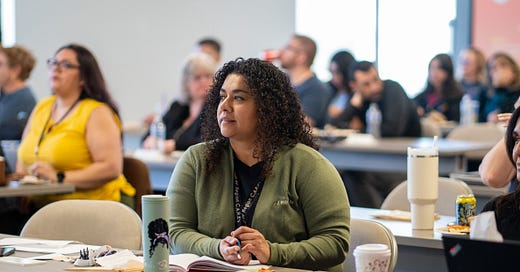Teens Are Asking Schools To Play A Critical Role In Their Mental Health Needs
Young people want schools to play a bigger role in their mental health, and they trust the information they get there, according to a recent survey by the National Alliance on Mental Health (NAMI). More than two-thirds of students agree schools should teach what mental health is, and where and how to seek treatment. Yet only 40 percent of teens say their school has specific programs or resources to support mental health.
The perception is nearly aligned with reality. As a recent Pew Research analysis found …
Overall, just over half of U.S. public schools (55 percent) provided students with diagnostic mental health assessments to evaluate them for mental health disorders during the 2019-20 school year, according to the National Center for Education Statistics’ (NCES) School Survey on Crime and Safety. These assessments were conducted by a licensed mental health professional employed or contracted by the schools.
Among public schools that made mental health assessments available for students, 61 percent provided them both at school and outside of school, and 29 percent offered them at school only. Just 11 percent provided them only outside of school.
This creates issues for students in dire need of critical mental health services, particularly as crisis arises. Take student Alexandria T. for example: her home life was rocky, and she struggled with mental health challenges, including ADHD, anxiety and depression. In high school, she got little support and found it hard to concentrate on studies. Instead of dropping out, she transferred to a network of 80+ public high schools known as Learn4Life that offers personalized instruction and a trauma-resilient approach. Alexandria finally received the help she needed.
Models such as this have offered a trauma-resilient approach for the past 15 years. In California and a few other states, Learn4Life takes it a step further by having hundreds of its student-facing staff such as teachers, tutors, counselors, social workers and more become certified professionals through Trauma-Resilient Educational Communities (TREC).
The TREC model, based on Positive and Adverse Childhood Experiences (PACES) science and protocols, is an active, integrated approach to learning and practicing the skills of a trauma-resilient education. This 20-hour curriculum includes identifying trauma in students and teaching them how to build resilience in the face of life’s ups and downs while developing healthy, trusted relationships. TREC schools practice restorative justice rather than punishing students who might be acting out as a response to trauma.
The multi-phase certification program ensures educators understand trauma, while being culturally responsive to cultivate an environment of love, compassion and empathy for every student. A key element is the importance of engaging in self-care and mindfulness to avoid teacher burnout. The program benefits entire educational communities by providing useful techniques to create harmony in and outside of the classroom.
“Students in trauma respond in different ways, but at school it can manifest in things like truancy, difficulty concentrating, isolation and risky behavior like substance abuse,” explained Craig Beswick, trauma resiliency specialist at Learn4Life. “We know that before we can reach students’ heads, we need to reach their hearts.”
According to Beswick, students who are engaged with TREC resiliency programs and social-emotional learning curriculum earn 17 percent more credits per learning period compared to non-TREC engaged students, and graduate at a six percent higher rate.
Ultimately, Alexandria graduated from Learn4Life and became a student at San Diego State University working toward a bachelor’s degree in child development. She now plans to apply to that master’s program in social work or counseling.
“This experience taught me that even when you think the whole world is against you, there are always people out there who care about you. They want to see you succeed, but you have to be open to receive the support,” she said.
May is Mental Health Awareness Month. It was started by NAMI in 1949 to end the stigma of mental health, extend support and advocate for policies that prioritize the well-being of individuals and families affected by mental illness. Schools can be that first stepping stone towards offering the resilience foundation young people need. The creation and expansion of mental health support and restorative justice services is also one of the keys to rebuilding public school systems, especially as they face a myriad of challenges disproportionately impacting Black and Brown students.






